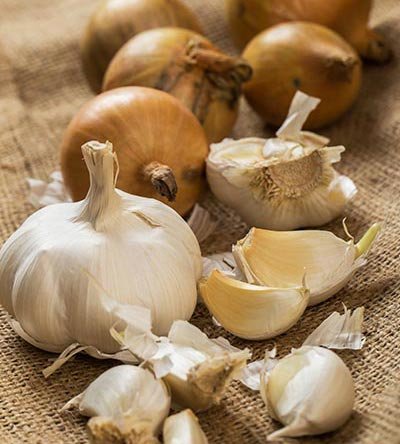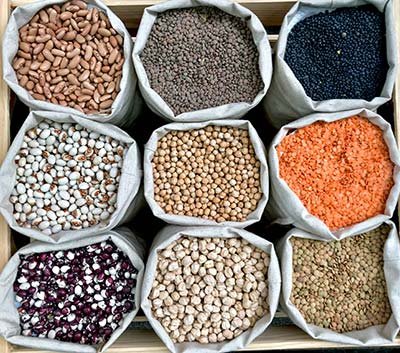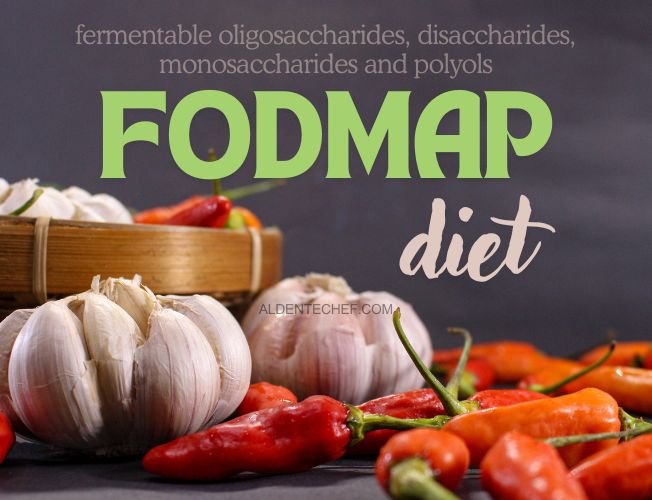The FODMAP diet is a type of diet developed for individuals experiencing irritable bowel syndrome (IBS), SIBO, gas, bloating, indigestion and other digestive problems. Some foods you consume during the day trigger your digestive problems. Finding these trigger foods is not easy, takes time and requires careful monitoring.
The FODMAP diet helps you find the trigger foods that create problems in your digestive system. This diet does not treat the underlying disease. But once you learn the foods you are sensitive to, it becomes easier to control your symptoms.
What are the foods and habits that cause gas?Click to learn.
FODMAP is an acronym for short-chain carbohydrates and sugar alcohols. It stands for:
- Fermentable
- Oligosaccharides
- Disaccharides
- Monosaccharides
- And
- Polyols
These carbohydrates are not fully absorbed by the digestive system and therefore cause fermentation in the intestines. The gases that are produced as a result of fermentation cause bloating in the abdomen. At the same time, the intestines may absorb more water than normal, causing diarrhea. This situation creates great discomfort, especially for individuals with sensitive intestines.
The FODMAP diet restricts a variety of carbohydrates. However, it is not like ketogenic or other low-carb diets. You should be careful not to consume high-FODMAP carbohydrates. You can include low-FODMAP carbohydrates in your diet at levels you can tolerate.
When to Try Low FODMAP Diet?
When your body can’t digest the carbohydrates we call FODMAPs (starch, sugar, and fiber), bacteria in your gut ferment these foods. As a result, you may develop abdominal pain, bloating, diarrhea, or constipation.
The FODMAP diet was developed specifically to deal with intestinal health issues. The aim of the diet is to create a nutrition plan by identifying trigger foods. These symptoms usually include intestinal gas, bloating, diarrhea or constipation.
Benefits of the Low FODMAP Diet
With FODMAP diet, 75% of patients with IBS and intolerance experience relief within a week. In general, the benefits of the FODMAP diet are as follows:
☛Symptom Management: Reduces abdominal pain, gas and bloating.
☛Intestinal Peace: Soothes digestion and balances intestinal flora.
☛Individual Tolerance: Helps a person learn which foods they are sensitive to.
☛Increase in Quality of Life: When discomfort is eliminated, the quality of life increases.

Who Should Follow the FODMAP Diet?

1. Irritable Bowel Syndrome (IBS):
- The FODMAP diet is most recommended for people with IBS.
- People with IBS experience abdominal pain, bloating, gas, and irregular bowel movements when they consume high-FODMAP foods.
- The FODMAP diet is very effective in relieving these symptoms.
2. Inflammatory Bowel Diseases (IBD):
- In inflammatory bowel diseases such as Crohn’s disease and ulcerative colitis, diet helps manage symptoms.
- However, in these diseases, diet therapy should be applied together with medical treatment.
3. Functional Dyspepsia:
- The FODMAP diet may provide relief for people with symptoms like pain, bloating, and indigestion.
4. Lactose Intolerance:
- Lactose is a high-FODMAP carb. Removing it from the diet reduces symptoms of lactose intolerance.
5. Gluten Sensitivity (Non-Celiac):
- People who don’t have celiac disease but are gluten sensitive may find relief.
6. SIBO (Small Intestinal Bacterial Overgrowth):
- In SIBO, which is characterized by bacterial overgrowth in the small intestine, reducing foods high in FODMAPs relieves symptoms.
7. Diabetes and Metabolic Syndrome:
- Although it is not a direct treatment method in these cases, it is useful in relieving the digestive system.
How to Do a FODMAP Diet?
You don’t need to completely eliminate any food groups on the FODMAP diet. You just need to find and eliminate the foods that trigger you. For example, you can choose low-FODMAP foods without sacrificing all fruits and vegetables.
It is necessary to avoid all foods that contain high FODMAPs during the first few weeks of the diet. At this stage, you can get help from a specialist to ensure that you are getting your daily nutritional needs in a balanced way.

FODMAP Diet Stages
The FODMAP diet consists of three main phases:
➤Elimination: This is the period when high FODMAP foods are completely removed from the diet. It lasts for a few weeks. During this period, your symptoms will decrease rapidly. Your digestive system will return to normal. It is recommended that elimination be continued for 2 to 6 weeks.
➤Reintroduction: Specific foods are added back to the diet one by one in a controlled manner. It should be understood which foods are causing problems and how well they are tolerated. Reintroductions should be made at 3-day intervals. In other words, a high-FODMAP food is added to the diet every 3 days. If a food that causes too many symptoms is detected, it should be completely removed from the diet.
➤Personalization: The foods and amounts that the individual can tolerate should be determined and a new diet plan should be created.
Once you have identified the trigger foods that cause symptoms, you can now safely consume other foods.
Before you start a FODMAP diet, I recommend that you seek advice from a doctor or dietitian who specializes in this area. This way, you can implement the diet much more easily and effectively.
High & Low FODMAP Foods
The table below includes high and low FODMAP foods from all food groups:
| HIGH FODMAP FOODS Forbidden✘ | LOW FODMAP FOODS Allowed✔ | |
| Vegetables | Garlic, onion, shallot, white part of green onion, cauliflower, cabbage, mushroom, green peas, celery, fennel, beet | Green beans, eggplant (1 cup), red bell pepper, green pepper (1/2 cup), carrot, cucumber, zucchini, lettuce, potato, tomato, green parts of green onion, turp (1/2), pumpkin, spinach, sweet potato |
| Fruits | Apple, apple juice, cherry, pear, watermelon, dried fruits, mango, nectarine, peach, plum, avocado, ripe banana, blackberry, grapefruit, mango, grape, apricot | Melon, kiwi, tangerine, orange, pineapple, blueberry, unripe banana, cranberry, lemon, lime, strawberry (5 pieces), olive |
| Dairy | Milk (sheep, goat, cow), buttermilk, yogurt, ice cream, cream, white cheese, kefir, sour cream (more than 2 tbsp) | Almond milk, lactose-free milk, coconut milk (1/2 cup), rice milk, hard cheeses, mozzarella, parmesan, butter |
| Proteins | Processed meat products (you should check the ingredient list of products such as sausages, to see if they contain high FODMAPs (garlic, onion, etc.) | Egg, meat, chicken, fish, turkey, fish, canned tuna, crab, lobster, mussels, oysters, shrimp (all meat products should be cooked plain if possible, or their marinades should not contain prohibited ingredients) |
| Grains and Legumes | Wheat or rye flour products; bread, pasta, noodles, noodles, biscuits, couscous etc. muesli, granola, cereal, barley, bran, semolina, bread crumbs | Gluten-free products, oats, quinoa, buckwheat, corn flour, popcorn, rice, pysillium |
| Sugar, Sweeteners and Sauces | Inulin, Isomalt (E953 / 953), Lactitol (E966 / 966), Maltitol (E965 / 965), Mannitol (E241 / 421), Sorbitol (E420 / 420), Xylitol (E967 / 967), fructose-containing products, corn syrup, honey, wasabi, creamy pasta sauces | Erythritol, stevia, table sugar, aspartame, saccharin, sucralose, glucose, dark chocolate (5 squares), soy sauce, mayonnaise, mustard, tomato sauce, strawberry/raspberry jam, maple syrup |
| Nuts | Cashew, pistachio | Walnuts, almonds (10 pieces), peanuts, sunflower seeds, pumpkin seeds, chestnuts, hazelnuts, sesame seeds |
| Drinks | Apple/pear/mango juice, strong herbal teas, sodas and carbonated drinks containing high fructose corn syrup, kombucha | Water, coffee (plain), light herbal teas, lightly brewed black or green tea, mint tea, beer and wine (max one glass each, orange juice (max 1/2 cup) |
Click hereto learn more tips to reduce gas and bloating other than the FODMAP diet.
Things to Pay Attention
★Onions and garlic, including powdered forms, should not be taken during the elimination period.
★Be careful when purchasing processed products, all kinds of sauces, mixed fruit teas and instant drinks. It is necessary to examine the labels of these products and check if they contain high FODMAP content. It is best to stay away from packaged products completely during the elimination period.
★The portion sizes of foods affect the FODMAP content. Your body can tolerate some foods when you don’t consume too much. It is necessary to pay attention to portion sizes without ignoring this.
The FODMAP diet does not cure diseases. Its purpose is to create a diet that will relax the intestines.
- The FODMAP diet should be implemented with the help of a dietitian or gastroenterologist. Especially individuals who are already underweight should implement this diet under the supervision of a specialist in order not to lose even more weight during the elimination period.
- Each individual’s FODMAP sensitivity is different, so the diet should be personalized.
- A long-term elimination diet should not be implemented, a balanced nutrition plan should be created.
The FODMAP diet is an effective method, especially for people with chronic digestive disorders. However, if not implemented correctly, it can cause more harm than good. This is why it is important to seek professional guidance.
Dietitian S. M. Erturhan

